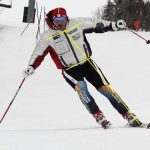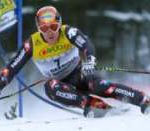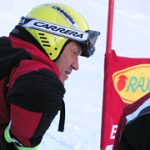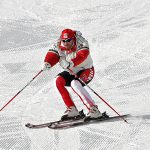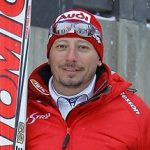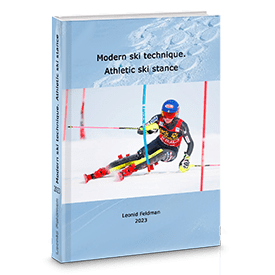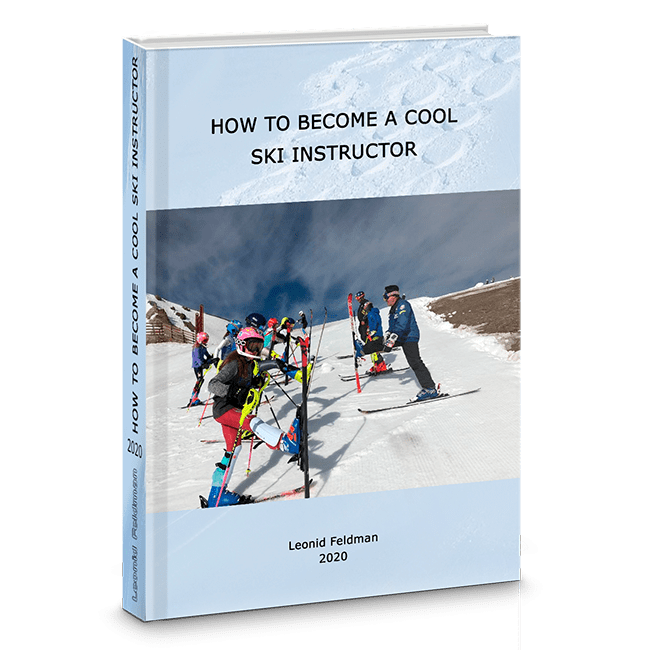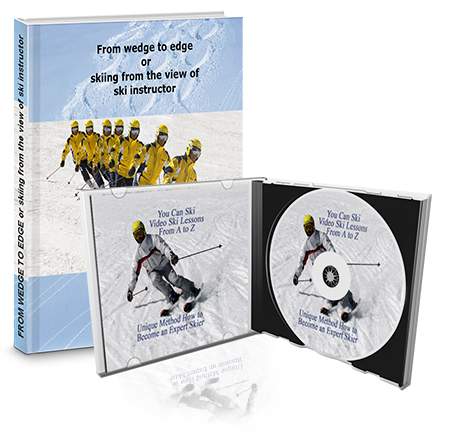Specific Characteristics of the Austrian Racing Technique
General guidelines (apply to all kinds of turns, from slalom to downhill):
- Open athletic stance with skis positioned wide.
- Basic stance generally stays the same (may change slightly to fit the terrain).
- No steps or stepping-type movements.
- Upper body is upright and slightly forward.
- Upper body position should not unfold or extend to resist the pressure built-up in the turn.
- Skis are kept parallel.
Turn progression:
Photos of Hermann Maier (GS) and Benjamin Raich (SL) by Stan Petrash
1. Transition
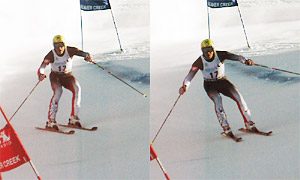
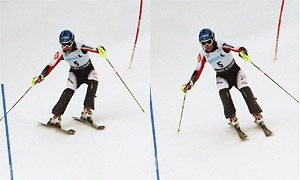
During the unloading phase in transition, the upper body remains in neutral position, while skis, legs and knees cross under the body into a new turn in pendulum-like motion.
2. Initiation
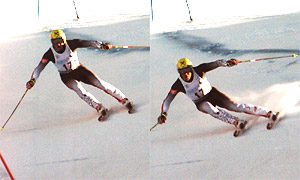
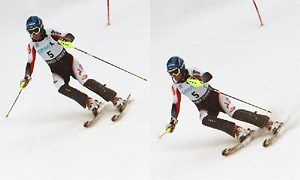
During the initiation stage pressure is building up mostly on the outside ski. Inside ski is also used troughout the turn and carries some weight.
3. Fall-line
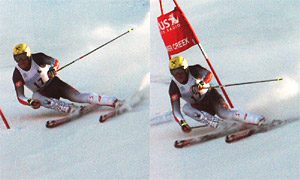
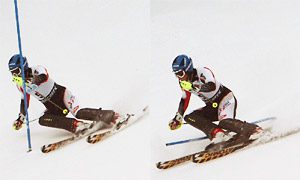
Upon entering the fall-line, pressure increases slightly (basic stance should stay the same or slightly more extended/stretched). Getting too far back should be avoided.
4. Exiting Fall-line
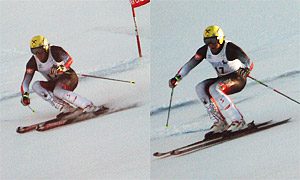
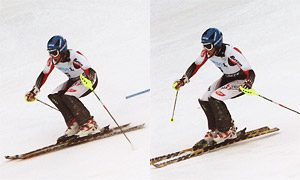
Exit out of the fall line and un-weighting of the skis are performed by a fluid transition from the outside ski onto the inside ski (the new outside ski).
Editor’s Note
Common Mistakes and Their Correction
Basic Principles of Mistake Correction:
- First understand the cause of the problem, only then try to correct it.
- Don’t point several mistakes at once.
- Don’t mention the same mistake over and over again. Include positive feedback into the criticism.
- It is very important to bring positive aspects into correction process.
- Give well defined tasks to correct mistakes.
Problem: Initiation of a turn without enough commitment to the outside ski
Primary causes:
- Psychological components: fear of speed, hill’s too steep.
- Turn initiation is performed too early or too late: lack of technical skills.
- Movement of the entire body to the inside of the turn comes too early.
Correction:
In free skiing
- Double pole plant on the outside.
- Grabbing the outside-knee.
- Active break at the hip.
- Fast short turns.
In gates
- Run through straight upright gates without touching.
- Run through gates leaning to the outside.
- Use inside clear in straight upright gates.
- Use stubbys or markers for turn initiation.
- Grab to the outside leg in the points marked by stubbies.
Keep a good mix of drills. It is always recommended to do some free skiing in between the sessions as well as doing free skiing drills.
Problem: Skis are too close together
Correction:
- Have racer ski with some pads (ball, foam tire) between the knees.
- Set the course with stubbys and have racers ski over them (having stubbys go between the skis).
- Have racers ski with the skis extra-wide (imagine to be a gorilla or tractor or train etc.).
- Have racers ski in tuck position by letting the skis “roll over” from one set of edges to the other while looking at the ski tips and keeping them apart.
- If snow is soft enough let them follow the wide track of another skier in front.
Problem: Leaning in too much
Correction:
- Set gates leaning slightly to the outside
- Go back to some basic techniques:
- Turning on the outside ski only.
- Keeping outside hand lower in the turn.
- Pushing inside-ski forward / backward.
Problem: Stepping
Correction:
- Turns in the fall line.
- Keeping the ski tips level (on the same height).
Problem: Leaning too far back or too far forward
Correction:
- Check the equipment (boots, insoles, canting etc.).
- Go back to lessons on basic stance:
- Ski in upright position.
- Focus on arms position, see if they are stretched too far forward/back.
- “Contrast-practice”:
- Have racers lean extremely far back/forward.
- Adjust and feel the appropriate neutral position.
Problem: Taking too straight of a line in the course
Correction:
- Use helper gates set above the gate and below it. Keep moving them further and further out of the fall line.
Problem: Not enough pressure in the fall line
Correction:
- Drills on holding an extended position or stretching movements.
- Drills in tuck position (if available over the rolls) working on active “pushing down”.
- Drills on going straight in tuck position and getting into the turns.
Problem: Set-up phase of the turn is too short (trajectory is not “round” enough)
Correction:
- Set tight and “turny” course and use stubbys in different combinations.
Problem: Lack of timing
Correction:
Set a simple course setting with turn-helper gates, emphasize active stretching (extension). Could be practiced in the rolling terrain (bend knees on top of the roll, actively stretch in the valley in between the rolls).
Coming Soon: Part II of Austrian Coaching Method: Gate Training.
Editor’s Note: In the above images, at first glance one may get an impression that both racers appear to exhibit a significant “tip lead” (the inside ski is significantly ahead of the outside ski), especially in phases 2 and 3. We would like to emphasize that athletes DO NOT intentionally push the inside ski forward or counter-rotate the pelvis to achieve this ski alignment. Instead, tip lead develops naturally, due to extremely high edge angles developed by these top racers. Such extreme edge angles require rather large lateral separation between inside and outside feet, which in turn causes longtitudional separation of the skis (as a result of a simple anatomical fact that human knee articulates forward. Grasshoppers, for example, would exhibit a negative tip lead). Note, that as soon as the egde angle is reduced (phase 4-1), tip lead disappears, because racer’s pelvis stays “square” to the skis throughout the turn (i.e. an imaginary line drawn trough hip sockets is always perpendicular to the longtitudional axis of skis). What looks like “counter-rotation” in the first Raich’s photo, during the transition phase, is, in fact, an anticipatory projection of the upper body into the new turn, which happens ABOVE the pelvic girdle, in the abdominal area. This type of movement is most often seen in slalom (in steep, tight sections), seldom in GS, and virtually non-existent in superG and downhill


